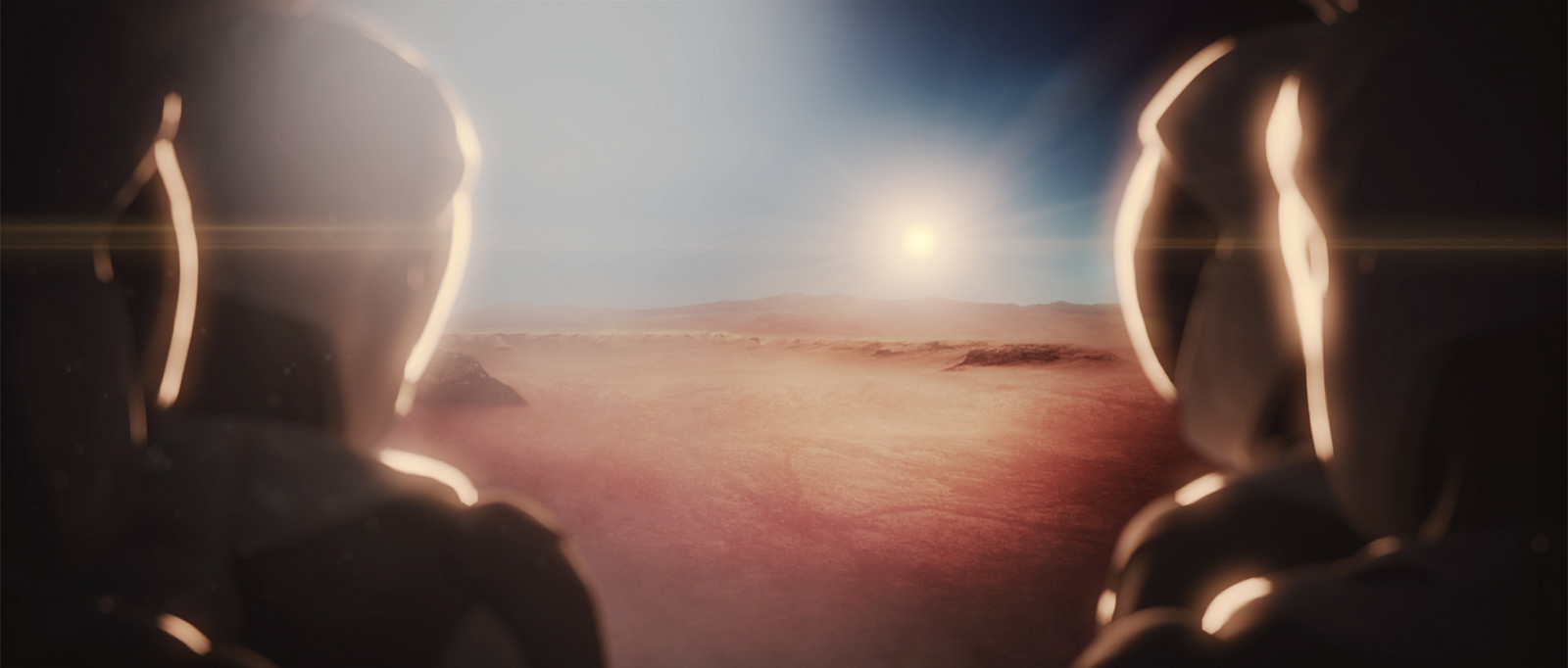SpaceX
Elon Musk has already “won” Mars by changing Boeing’s conversation

Boeing vs. SpaceX? Hmm.
In the Mel Brooks film, “Robin Hood: Men in Tights”, there’s an amusing scene wherein the Sheriff of Rottingham challenges Robin Hood to a duel after he and his men crash Prince John’s party. After uttering the challenge, the Sheriff proceeds to slap Robin across the face with his metro-sleek leather glove. In response, Robin picks up a heavy, metal-armored knight glove and whacks him across the face to accept.

Not a perfect metaphor, but close enough for our purposes. Credit: Web Summit, with clip art addition and filters.
I guess you see where I’m going with this. Now that I’ve introduced the topic visually…
Boeing Brings Out the (Leather) Mars Glove
When I saw headlines claiming that Boeing would “beat” SpaceX to Mars, I had two thoughts:
- Well isn’t that nice of Boeing to officially throw their hat in the ring after they helped take us to the moon? And…
- Wasn’t this the entire point of SpaceX’s push for Mars in the first place?
I definitely understand the need for competition to drive innovation among the general human population. I also certainly understand that it was the “space race” against the Soviets that took us to the moon, so overstating a competition is more PR move than reality; however, given the non-aggressive nature Elon has taken towards developing the technology to get us to the elusive red planet (i.e., more focused on getting us there than saying much about the competition), I was expecting to have missed something from SpaceX judging by the sudden grandiose claims. Did I overlook a Google Alert on something Elon said that caused Boeing to bite back?
Er, okay. Maybe Elon’s prior non-complimentary remarks on Boeing’s approach to surface landing wasn’t given or received in the most cooperative spirit. Technology designers are allowed to disagree, right? I’m sure the comment only helped fuel the fires of speculation. That, along with the fact that we are a tabloid-minded species that likes to understand the world through the lens of “us vs. them”, and we see boxing-style headlines on the Mars missions rather than the shoulder shrug, head-nod variety of mutual goal pursuit.
Alternatively, the Boeing step-up could have just been a result of their new guy (CEO/Chairman/President) at the helm. Along with an engineering background and having spent his entire career at Boeing, Dennis Muilenburg actually has some spunk. He seems like a cool dude, pretty inspired by Boeing’s history, confident in its future, and quite honestly, I wish he would don a long-haired wig and give us a Zaphod Beeblebrox number for Halloween. Seriously. Watch his recent AtlanticLIVE interview, and then watch Hitchhiker’s Guide to the Galaxy (2005). You’ll see what I mean (at 1:51 specifically). That’s got to be a winning combination, no?
[P.S. I am in no way implying that you are not allowed to have a full brain to be the head of Boeing.]
Elon Has Already “Won” Mars
In terms of accomplishment (and his own standards), Elon has already done what he set out to do with SpaceX originally. With an anticipated success rate of “less than 10%” for the company, he was already okay with the company closing up shop after a good try in the hopes that someone else would “pick up the baton”. Getting a 100-year old curmudgeon tech company on the bandwagon for interplanetary travel? That’s a “win” right there if I’ve ever seen one.

The best part about all of this Mars chatter? It’s officially moved into the zone of potential realities. Where Mars habitation was only the stuff of science fiction in the past, now “…success is one of the possible outcomes,” to quote Elon’s exact words.
Considering all the considerables (including Elon’s own mention of multiple companies heading for Mars being a good thing), there really isn’t a big race for Boeing to chomp at here. Whether SpaceX is first with Falcon Heavy or Boeing gets there with its Space Launch System, everybody wins. #teamHuman
Of course, I think having coffee shops and movie theaters for the journey is way more awesome than an oversized capsule, but until I have some $200k in pocket cash for a ticket, that’s none of my business.
Onwards.

Elon Musk
Elon Musk’s Biggest Revelations on AI, Robots, and the Future of Work from the Moonshots Podcast

Elon Musk’s appearance on the Moonshots with Peter Diamandis podcast was packed with bold predictions, candid admissions, and surprising tech insights. The nearly three-hour conversation covered everything from artificial intelligence to humanoid robots, geopolitics, and the future of work. Here are the top 10 most intriguing takeaways:
-
Aggressive AGI Timeline Predictions
Musk offered a detailed view on when artificial general intelligence (AGI) could emerge, suggesting it may arrive sooner than many expect, emphasizing both transformative potential and risks.
-
U.S. vs. China in the AI Race
He discussed the strategic competition between the United States and China over AI development, noting that geopolitical dynamics will shape how and who leads in the next decades.
-
Future of Job Markets
Musk touched on how AI and automation could reshape employment, predicting massive boosts in productivity alongside potential disruptions in traditional work structures.
-
Clean Energy Transition
A recurring theme was the role of clean energy in future economies, with Musk reiterating the importance of scaling sustainable power generation and storage.
-
Humanoid Robots Are Coming
On the podcast, Musk elaborated on Tesla’s work on humanoid robots, hinting at timelines and applications that go beyond factories to general-purpose assistance.
-
Tesla Roadster “Last Human-Driven Car”
Outside the core discussion topics, Musk teased features of the upcoming Tesla Roadster — calling it “the best of the last of the human-driven cars” and suggesting safety won’t be its main selling point.
-
The Role of AI in Clean Energy and Robotics
Linking AI to both energy optimization and robotics, Musk explained how smarter systems could accelerate decarbonization and task automation across industries.
-
U.S. Innovation Leadership
Musk argued that maintaining American leadership in key tech sectors like AI, space, and robotics should be a national priority, with thoughtful policy and investment.
-
Job Creation vs. Job Elimination
While acknowledging automation’s disruptive effects, he also outlined scenarios where new industries and opportunities could emerge, particularly in AI, space, and advanced manufacturing.
-
Long-Term Vision for Humanity
Throughout the conversation, Musk revisited his long-term philosophical views — including a belief in humanity’s responsibility to become a multi-planetary and technologically empowered species.
Whether you agree with Musk’s optimism or not, the podcast offers a window into the thinking of one of the most influential figures in tech today, in and why his visions continue to spark debate and inspiration.
Elon Musk
Starlink achieves major milestones in 2025 progress report
Starlink wrapped up 2025 with impressive growth, adding more than 4.6 million new active customers and expanding service to 35 additional countries, territories, and markets.

Starlink wrapped up 2025 with impressive growth, adding more than 4.6 million new active customers and expanding service to 35 additional countries, territories, and markets. The company also completed deployment of its first-generation Direct to Cell constellation, launching over 650 satellites in just 18 months to enable cellular connectivity.
SpaceX highlighted Starlink’s impressive 2025 progress in an extensive report.
Key achievements from Starlink’s 2025 Progress
Starlink connected over 4.6 million new customers with high-speed internet while bringing service to 35 more regions worldwide in 2025. Starlink is now connecting 9.2 million people worldwide. The service achieved this just weeks after hitting its 8 million customer milestone.
Starlink is now available in 155 markets, including areas that are unreachable by traditional ISPs. As per SpaceX, Starlink has also provided over 21 million airline passengers and 20 million cruise passengers with reliable high-speed internet connectivity during their travels.
Starlink Direct to Cell
Starlink’s Direct to Cell constellation, more than 650 satellites strong, has already connected over 12 million people at least once, marking a breakthrough in global mobile coverage.
Starlink Direct to Cell is currently rolled out to 22 countries and 6 continents, with over 6 million monthly customers. Starlink Direct to Cell also has 27 MNO partners to date.
“This year, SpaceX completed deployment of the first generation of the Starlink Direct to Cell constellation, with more than 650 satellites launched to low-Earth orbit in just 18 months. Starlink Direct to Cell has connected more than 12 million people, and counting, at least once, providing life-saving connectivity when people need it most,” SpaceX wrote.
Elon Musk
Starlink passes 9 million active customers just weeks after hitting 8 million
The milestone highlights the accelerating growth of Starlink, which has now been adding over 20,000 new users per day.

SpaceX’s Starlink satellite internet service has continued its rapid global expansion, surpassing 9 million active customers just weeks after crossing the 8 million mark.
The milestone highlights the accelerating growth of Starlink, which has now been adding over 20,000 new users per day.
9 million customers
In a post on X, SpaceX stated that Starlink now serves over 9 million active users across 155 countries, territories, and markets. The company reached 8 million customers in early November, meaning it added roughly 1 million subscribers in under seven weeks, or about 21,275 new users on average per day.
“Starlink is connecting more than 9M active customers with high-speed internet across 155 countries, territories, and many other markets,” Starlink wrote in a post on its official X account. SpaceX President Gwynne Shotwell also celebrated the milestone on X. “A huge thank you to all of our customers and congrats to the Starlink team for such an incredible product,” she wrote.
That growth rate reflects both rising demand for broadband in underserved regions and Starlink’s expanding satellite constellation, which now includes more than 9,000 low-Earth-orbit satellites designed to deliver high-speed, low-latency internet worldwide.
Starlink’s momentum
Starlink’s momentum has been building up. SpaceX reported 4.6 million Starlink customers in December 2024, followed by 7 million by August 2025, and 8 million customers in November. Independent data also suggests Starlink usage is rising sharply, with Cloudflare reporting that global web traffic from Starlink users more than doubled in 2025, as noted in an Insider report.
Starlink’s momentum is increasingly tied to SpaceX’s broader financial outlook. Elon Musk has said the satellite network is “by far” the company’s largest revenue driver, and reports suggest SpaceX may be positioning itself for an initial public offering as soon as next year, with valuations estimated as high as $1.5 trillion. Musk has also suggested in the past that Starlink could have its own IPO in the future.








